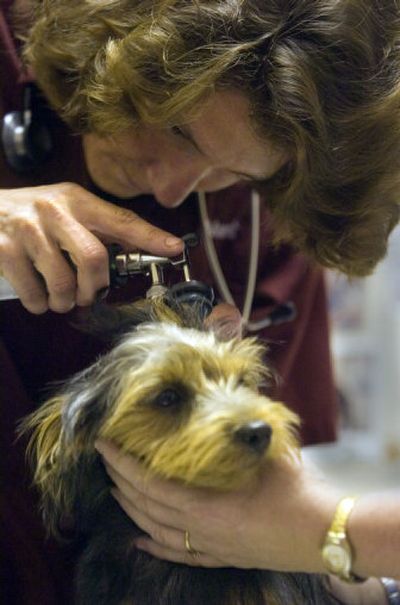Dog ears merit close attention

Your dog is scratching her ears, tilting her head, or shying away when you go to pat her on the head. You look at her ears and notice one is red, waxy and smelly. These can all be signs of one of the most common problems that dogs and their owners have to deal with—otitis externa or inflammation of the external ear canal.
Most people are immediately concerned that the problem might be ear mites, and, in fact, ear mites are a common problem in cats and kittens. In dogs, however, ear mites are rarely the problem. Dogs more often suffer from yeast infections or bacterial infections of the ear canal, and sometimes these infections can become chronic.
Sometimes, the cause of an ear infection is obvious. This time of year, we see a lot of grass seeds or cheat grass stuck in the ear canal. Cheat grass is usually good news because we can make the dog feel a lot better by removing it and treating the resultant infection. Certain breeds of dog, like poodles and Schnauzers, have excess hair growing inside their ear canals. If this hair is not removed, it will block air flow, trap moisture, and create an environment in which yeast or bacteria multiply.
When ear infections occur without any obvious inciting cause, they can still be treated successfully. Your vet will take an ear swab to rule out mites, and to see if there are yeast or bacteria (or both) present. Treating these secondary invaders may be the end of the problem … or not. This is where things can get frustrating. Many dogs improve with treatment only to have the infection recur within a few days or weeks after stopping the treatment. Many of these dogs are predisposed to ear infections because they have underlying allergies. So, in addition to treating your dog’s ear recurring infection you may need to put your dog on a hypoallergenic diet to see if this helps prevent the infection from returning. Dogs with ear and skin problems can improve with good control of the underlying allergies.
Recent studies have shown that many dogs get recurrent external ear infections because they also have otitis media, an infection of the middle ear. This means infection extends into the ear deeper than the ear drum. Your vet may recommend radiographs of the skull to see if there are changes consistent with this and may prescribe several weeks of an antibiotic. Your dog may have to have a procedure called myringotomy, in which fluid is drawn out from the middle ear (under anesthesia) and cultured to determine which antibiotic will work best. Very severe and chronic infections will cause calcium deposits in the soft tissues of the ear canal. If this mineralization progresses too far, then surgical removal of the external ear canal may be necessary. This is major surgery, but sometimes necessary for dogs who’ve suffered through years of painful ears.
What can you do to minimize the risk of otitis externa? As much as possible, keep weeds and tall grasses cut short to prevent grass seeds getting into the ear. After your dog swims or has a bath, apply a cleaning/drying agent to both ears. If you’re not sure which one to use, ask your vet for a recommendation.
If your dog has been diagnosed with an ear infection, make sure you get the prescribed medication all the way into the ear canal, and use an ample amount. A dog’s ear canals are huge compared to ours. The canal goes straight down along the side of the dog’s head and then makes right angle turn inward, toward the skull. You can feel the ear canal running under the skin on the side of the head. When cleaning the ear, use enough cleanser that you can see it welling out of the ear when you massage the ear canal.
Most importantly, make sure you follow through with rechecks to confirm the infection is gone. Usually, you and your vet can figure out which medications or cleansers help your dog and can prevent or minimize future infections.